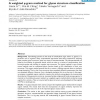BMCBI
2010
13 years 11 months ago
2010
Background: Pathways provide topical descriptions of cellular circuitry. Comparing analogous pathways reveals intricate insights into individual functional differences among speci...
BMCBI
2010
13 years 11 months ago
2010
Background: As a novel cancer diagnostic paradigm, mass spectroscopic serum proteomic pattern diagnostics was reported superior to the conventional serologic cancer biomarkers. Ho...
BMCBI
2010
13 years 11 months ago
2010
Background: MicroRNAs (miRNAs) play an essential task in gene regulatory networks by inhibiting the expression of target mRNAs. As their mRNA targets are genes involved in importa...
BMCBI
2010
13 years 11 months ago
2010
Background: Conserved gene clusters are groups of genes that are located close to one another in the genomes of several species. They tend to code for proteins that have a functio...
BMCBI
2010
13 years 11 months ago
2010
Background: The study of genome rearrangements has become a mainstay of phylogenetics and comparative genomics. Fundamental in such a study is the median problem: given three geno...
BMCBI
2010
13 years 11 months ago
2010
Background: HIV-1 targets human cells expressing both the CD4 receptor, which binds the viral envelope glycoprotein gp120, as well as either the CCR5 (R5) or CXCR4 (X4) co-recepto...
BMCBI
2010
13 years 11 months ago
2010
Background: Tandem mass spectrometry (MS/MS) has become the primary way for protein identification in proteomics. A good score function for measuring the match quality between a p...
BMCBI
2010
13 years 11 months ago
2010
Background: Human Immunodeficiency Virus type 1 (HIV-1), the causative agent of Acquired Immune Deficiency Syndrome (AIDS), exhibits very high genetic diversity with different var...
BMCBI
2010
13 years 11 months ago
2010
Background: Many research results show that the biological systems are composed of functional modules. Members in the same module usually have common functions. This is useful inf...
BMCBI
2010
13 years 11 months ago
2010
Background: Glycobiology pertains to the study of carbohydrate sugar chains, or glycans, in a particular cell or organism. Many computational approaches have been proposed for ana...



